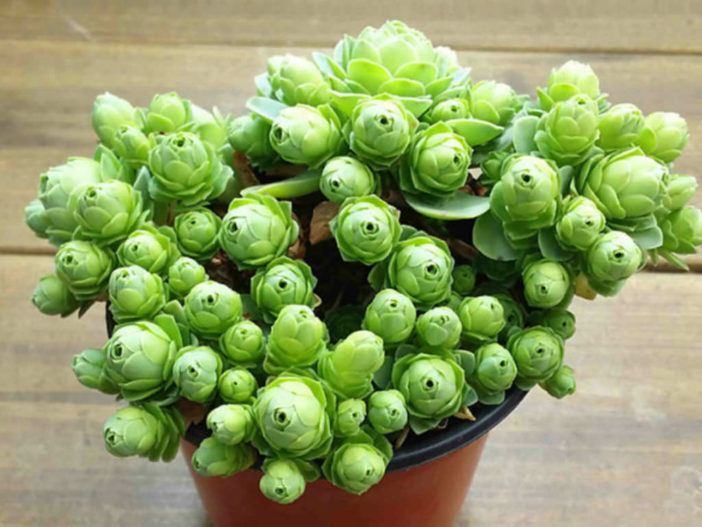Scientific Name
Aeonium dodrantale (Willd.) T.H.M.Mes
Common Name(s)
Mountain Rose
Synonym(s)
Sempervivum dodrantale, Greenovia dodrantalis, Greenovia gracilis, Sempervivum gracile
Scientific Classification
Family: Crassulaceae
Subfamily: Sempervivoideae
Tribe: Aeonieae
Genus: Aeonium
Description
Aeonium dodrantale, also known as Greenovia dodrantalis, is a succulent plant that forms rosettes of pale green densely packed leaves. The rosettes are tightly closed during the summer dormancy. They are cup- or urn-shaped, grow up to 2.4 inches (6 cm) in diameter, and produce offsets on up to 3.2 inches (8 cm) long stalks. Leaves are obovate-spatulate, apically rounded or truncate, up to 1.4 inches (3.5 cm) long, and up to 0.6 inches (1.5 cm) wide. They are glaucous, often very finely glandular-hairy when young, becoming glabrous with age.
The yellow flowers appear in clusters on strong stalks up to 10 inches (25 cm) above the foliage in spring.

Hardiness
USDA hardiness zone 10a to 11b: from 30 °F (−1.1 °C) to 50 °F (+10 °C).
How to Grow and Care
Aeoniums do not like hot or dry weather. They may go dormant in summer and do not require any water, except in arid conditions. In extreme heat, their leaves will curl to prevent excessive water loss. Growing them in moist shade will keep them growing, but their true growth season is winter to spring, when temperatures are cool, 65 to 75 °F (18 to 24 °C), and damp. In the winter, water whenever the soil has dried out. Test by poking your finger down into the soil an inch or 2 (2.5 to 5 cm). Too much moisture or allowing them to sit in wet soil will cause root rot.
A sandy loam or regular potting mix is better than a mix specifically for cacti and succulents since Aeoniums need some moisture. If you are growing them in containers, repot them every 2 to 3 years with fresh potting soil.
Feed during the growing season with a half-strength balanced fertilizer every month or so. Do not feed while dormant.
Learn more at How to Grow and Care for Aeonium.
Origin
This species is native to the Canary Islands.
Links
- Back to genus Aeonium
- Succupedia: Browse succulents by Scientific Name, Common Name, Genus, Family, USDA Hardiness Zone, Origin, or cacti by Genus
Photo Gallery
Click on a photo to see a larger version.



